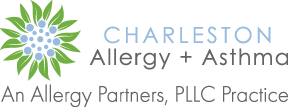[vc_row][vc_column][vc_column_text]Asthma is an inflammatory condition of the airways in your lungs. It effects 8-10% of the population – that’s 24 million Americans! Asthma usually begins in childhood but can occur in adulthood and is the #1 cause of missed school and work. Asthma is triggered by a variety of exposures detailed below.
[/vc_column_text][/vc_column][/vc_row][vc_row fadeout_row=”fadeout_row_value”][vc_column width=”1/6″][vc_single_image image=”11987″ img_size=”full” css=”.vc_custom_1569946763484{margin-bottom: -10px !important;border-bottom-width: -10px !important;padding-bottom: -10px !important;}”][/vc_column][vc_column width=”5/6″][vc_column_text]
1. Seasonal Viral Infections
Seasonal viral infections are the number one cause of asthma symptoms. The start of the school year typically brings on new germs, so we often see an uptick in viral infections during “back-to-school” time. The first week of school is singularly the worst week for pediatric asthma emergency room visits and hospitalizations. Viral infections often occur in epidemics, usually rhinovirus (common cold virus) in school age children and RSV (respiratory syncytial virus) in preschool age, typically associated with nasal congestion, runny nose, fever, and fatigue. These days, different strains of influenza viruses are coming through several times a year and, unfortunately, influenza immunizations have not been totally preventative the past few years. In the past, we would have a few epidemic years apart. Now, we’re seeing a flu epidemic 2-3 times a year and there are multiple strains making it difficult for the flu vaccine to be totally effective. [/vc_column_text][vc_separator][/vc_column][/vc_row][vc_row fadeout_row=”fadeout_row_value”][vc_column width=”1/6″][vc_single_image image=”11985″ img_size=”full” css=”.vc_custom_1569946779776{margin-bottom: -10px !important;border-bottom-width: -10px !important;padding-bottom: -10px !important;}”][/vc_column][vc_column width=”5/6″][vc_column_text]
2. Allergies
Allergies are one of the two biggest triggers for asthma and can be categorized into indoor and outdoor allergens. If you look at patients diagnosed with asthma, it’s likely that 75% of those patients have allergy triggers. Allergy triggers consist of year-round indoor allergies and seasonal outdoor allergies. Patients are often allergic to both.[/vc_column_text][vc_row_inner][vc_column_inner width=”1/6″][vc_single_image image=”11975″ img_size=”full” css=”.vc_custom_1569946819484{margin-bottom: -5px !important;border-bottom-width: -5px !important;padding-bottom: -5px !important;}”][/vc_column_inner][vc_column_inner width=”5/6″][vc_column_text]Indoor Allergy triggers that are the typical culprits are dust mites, cockroach, and pet dander. Dust mites live in every home in parts of the country with average humidity over 50% (we average 70%) and the typical bed in Charleston contains 1-2 million of these mites! They live on the dead skin that we sluff off when we sleep. Cockroach particles in house dust can also trigger worsening of asthma.
Indoor pets, both cats and dogs, can also worsen asthma symptoms. Cat allergen is present in saliva and can aerosolize through an entire home, making asthma very difficult to control. Interestingly, a recent survey by veterinarians asked over 1000 patients, “If the doctor told you to get rid of your pet, would you do it?” 75% said “no.” And we won’t ask you to either! We can provide suggestions for avoidance measures and, if necessary, discuss allergy injections so you don’t have to get rid of fur baby.[/vc_column_text][vc_separator][/vc_column_inner][/vc_row_inner][vc_row_inner][vc_column_inner width=”1/6″][vc_single_image image=”11976″ img_size=”full” css=”.vc_custom_1569946843034{margin-bottom: -5px !important;border-bottom-width: -5px !important;padding-bottom: -5px !important;}”][/vc_column_inner][vc_column_inner width=”5/6″][vc_column_text]Outdoor Allergies consist of trees, grasses and weeds. With global warming, these pollen seasons in the Lowcountry have become heavier and prolonged. Typically, our pollen starts in mid-January and lasts until early December. That’s not much of a break!
Pollen is heaviest in the mid to late morning and lower in late afternoon and evening. Pollen can also travel up to 200 miles (that’s a long way!!) and can be brought into the home on your clothing and on your pets. We can provide an allergy skin test to determine specifically which of these outdoor and indoor pollens are a problem for you. And if you are a candidate, we can discuss allergy injections to help you beyond avoidance measures.[/vc_column_text][vc_separator][/vc_column_inner][/vc_row_inner][/vc_column][/vc_row][vc_row fadeout_row=”fadeout_row_value”][vc_column width=”1/6″][vc_single_image image=”11977″ img_size=”full” css=”.vc_custom_1569946864694{margin-bottom: -10px !important;border-bottom-width: -10px !important;padding-bottom: -10px !important;}”][/vc_column][vc_column width=”5/6″][vc_column_text]
3. Molds
Molds are another allergen that is considered both indoor and outdoor allergenic. And we live in a community with very high heat and humidity – factors which can contribute to mold growth. In addition to cooling and heating, your air conditioning dehumidifies and controls indoor mold. When the air conditioner is off for 1-2 weeks (think about rental cabins and beach houses), mold can grow rapidly and become a problem for asthmatics coming into that environment. This is a problem found in schools, as well.[/vc_column_text][vc_separator][/vc_column][/vc_row][vc_row fadeout_row=”fadeout_row_value”][vc_column width=”1/6″][vc_single_image image=”11980″ img_size=”full” css=”.vc_custom_1569946881628{margin-bottom: -10px !important;border-bottom-width: -10px !important;padding-bottom: -10px !important;}”][/vc_column][vc_column width=”5/6″][vc_column_text]
4. Odors
Odors and strong scents can trigger asthmatic airways to constrict, particularly if the area with the offending smell is not well ventilated. Common odor triggers are perfume, cologne, household cleaners, chemicals (particularly bleach), and workplace solvents. Make sure that if you are exposed to these types of triggers you are in a well-ventilated area.[/vc_column_text][vc_separator][/vc_column][/vc_row][vc_row fadeout_row=”fadeout_row_value”][vc_column width=”1/6″][vc_single_image image=”11981″ img_size=”full” css=”.vc_custom_1569946901062{margin-bottom: -10px !important;border-bottom-width: -10px !important;padding-bottom: -10px !important;}”][/vc_column][vc_column width=”5/6″][vc_column_text]
5. Tobacco Smoke
Tobacco smoke and cigarette smoking in patients with asthma is a common cause for poorly controlled asthma. Additionally, exposure to secondhand smoke in a home can also make a child’s asthma more difficult to control. Smoking cessation is very difficult but there are currently new aids that can be helpful. [/vc_column_text][vc_separator][/vc_column][/vc_row][vc_row fadeout_row=”fadeout_row_value”][vc_column width=”1/6″][vc_single_image image=”11982″ img_size=”full” css=”.vc_custom_1569946918894{margin-bottom: -10px !important;border-bottom-width: -10px !important;padding-bottom: -10px !important;}”][/vc_column][vc_column width=”5/6″][vc_column_text]
6. Exercise
Exercise is a bigger trigger for asthma in younger children and adolescents as they are more physically active. Sustained running triggers asthma the most and swimming the least. The colder and dryer the ambient air, the worse Exercise Induced Asthma (EIA) will be. EIA can be prevented with treatment with bronchodilators (rescue inhaler) immediately before exercise. Properly controlled asthma will allow children’s activities to not be limited. Sometimes the cause of exercise related shortness of breath is not clear, and an exercise challenge (where the individual is evaluated for shortness of breath in activity) is helpful in determining diagnosis and treatment options. [/vc_column_text][vc_separator][/vc_column][/vc_row][vc_row fadeout_row=”fadeout_row_value”][vc_column width=”1/6″][vc_single_image image=”11979″ img_size=”full” css=”.vc_custom_1569946938675{margin-bottom: -10px !important;border-bottom-width: -10px !important;padding-bottom: -10px !important;}”][/vc_column][vc_column width=”5/6″][vc_column_text]
7. Medications
Medications can also trigger asthma in some adults. Typically, those medicines are aspirin or aspirin related anti-inflammatory drugs (NSAIDS) and beta blockers. Aspirin triggered asthma is frequently seen in connection with nasal polyps and chronic sinus disease. There are specific therapies available to these individuals, i.e. aspirin desensitization. [/vc_column_text][vc_separator][/vc_column][/vc_row][vc_row fadeout_row=”fadeout_row_value”][vc_column width=”1/6″][vc_single_image image=”11986″ img_size=”full” css=”.vc_custom_1569946985735{margin-bottom: -10px !important;border-bottom-width: -10px !important;padding-bottom: -10px !important;}”][/vc_column][vc_column width=”5/6″][vc_column_text]
8. Air Pollution
Air pollution coming from automobile exhausts and factories can also aggravate asthma. In larger cities, there may be days with high air pollution warnings asking those with respiratory diseases to stay indoors. Here in the Lowcountry, it is not as large a concern as heavier populated cities like Atlanta, Houston, and Chicago. But there are situations, like a forest fire in the Upstate or in North Carolina that could cause breathing problems for asthmatic individuals. [/vc_column_text][vc_separator][/vc_column][/vc_row][vc_row fadeout_row=”fadeout_row_value”][vc_column width=”1/6″][vc_single_image image=”11978″ img_size=”full” css=”.vc_custom_1569947199156{margin-bottom: -10px !important;border-bottom-width: -10px !important;padding-bottom: -10px !important;}”][/vc_column][vc_column width=”5/6″][vc_column_text]
9. Other Diseases
Other diseases, such as chronic sinus disease, obstructive sleep apnea, and gastroesophageal reflux, for example, may cause worsening asthma. Diagnosing and understanding the other types of underlying diseases that can negatively affect your asthma allows your board-certified allergist to better manage an individual’s asthma.[/vc_column_text][vc_separator][/vc_column][/vc_row][vc_row][vc_column][vc_column_text]
Seeking Treatment for Asthma
Proper diagnosis is key to understanding and treating your asthma. Being followed by a board-certified allergist who can help you navigate your diagnosis and educate you on knowing your specific triggers and how to treat exacerbations is essential to controlling your asthma. Your board-certified allergist will properly train you on your medications and help you understand the difference between rescue and maintenance inhalers.
Getting your asthma under control means a better quality of life, especially for pediatric patients. Early diagnosis and treatment for the younger population will lead to better emotional health and means they are less likely to develop allergies later in life. If you think you might have asthma, give us a call so we can get you back out there doing the things you love. [/vc_column_text][/vc_column][/vc_row]




